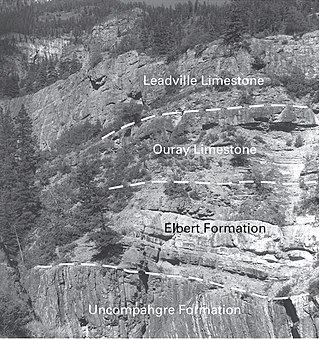| Pawnee Creek Beds | |
|---|---|
| Stratigraphic range: Miocene | |
| Type | Formation |
| Location | |
| Region | Colorado |
| Country | United States |
The Pawnee Creek Beds (also Pawnee Creek Formation) is a geologic formation in Colorado. It preserves fossils dating back to the Neogene period.
The Williamsport Sandstone is a sandstone geologic formation in West Virginia, Virginia, Pennsylvania, and Maryland. the formation includes the Cedar Creek Limestone member. Near Cumberland, Maryland it includes the Cedar Creek Limestone member. It preserves fossils dating back to the Silurian period.
The Pawnee Formation is a geologic formation in Illinois and Kansas. It preserves fossils dating back to the Carboniferous period.
The Porters Creek Formation is a geologic formation in Tennessee. It preserves fossils dating back to the Paleogene period.
The Java Formation is a geologic formation in Kentucky, New York, Ohio, Pennsylvania, Tennessee, Virginia, West Virginia. It preserves fossils dating back to the Devonian period. The formation comprises the Pipe Creek Shale, Wiscoy Sandstone Member in New York, and Hanover Shale Member except in Tennessee.
The Dotsero Formation is a geologic formation in Colorado. It preserves fossils dating back to the Cambrian period.
The Sawatch Formation is a geologic formation in eastern Colorado. It is a sedimentary sequence formed approximately 530 million years ago during a marine transgression. It preserves fossils dating back to the Cambrian period. It is composed of glauconitic and quartz-rich sandstone.

The Minturn Formation is a geologic formation in Colorado. It preserves fossils dating back to the Carboniferous period. Among the fossils preserved are of crinoids, spiriferid brachiopods, gastropods, and the spines and teeth of numerous sharks such as Petalodus
The Dyer Formation is a geologic formation in Colorado. It preserves fossils dating back to the Devonian period.

The Ouray Formation is a geologic formation in Colorado. It preserves fossils dating back to the Devonian period.
The Browns Park Formation is a geologic formation in Colorado. It preserves fossils dating back to the Neogene period.
The Troublesome Formation is a geologic formation in Colorado. It preserves fossils dating back to the Neogene period. It consists of Pale shades of pink, tan, gray, green, and white interbedded siltstone and mudstone, less abundant arkosic sandstone and conglomerate, and sparse limestone and altered crystal-vitric ash and tuff; generally poorly consolidated. It includes atypical deposits containing abundant pink, granitic cobbles and boulders along the western parts of the outcrop in the west-central and southwestern parts of the Granby Quadrangle, Fossil mammals from three sites indicate a late Oligocene age.
The Harding Sandstone is a geologic formation in Colorado. It preserves fossils dating back to the Ordovician period.
The Farisita Formation is a geologic formation in Colorado. It preserves fossils dating back to the Paleogene period.

The Huerfano Formation is a geologic formation in Colorado. It preserves fossils dating back to the Paleogene period.
The Middle Park Formation is a geologic formation in Colorado. It preserves fossils dating back to the Paleogene period.
The Ohio Creek Formation is a geologic formation in Colorado. It preserves fossils dating back to the Paleogene period.
The Animas Formation is a geologic formation in Colorado. It preserves fossils dating back to the Paleogene period.

The Maroon Formation is a geologic formation in Colorado. It preserves fossils dating back to the Permian period. It is the primary formation of sandstone that lends the vivid red color to the hills around Glenwood Springs, Colorado.
The Alamosa Formation is a geologic formation in Colorado. It preserves fossils. The formation was deposited by Lake Alamosa, a paleolake that existed from the Pliocene to the middle Pleistocene.
The Palm Spring Formation is a Pleistocene Epoch geologic formation in the eastern Colorado Desert of Imperial County and San Diego County County, Southern California.